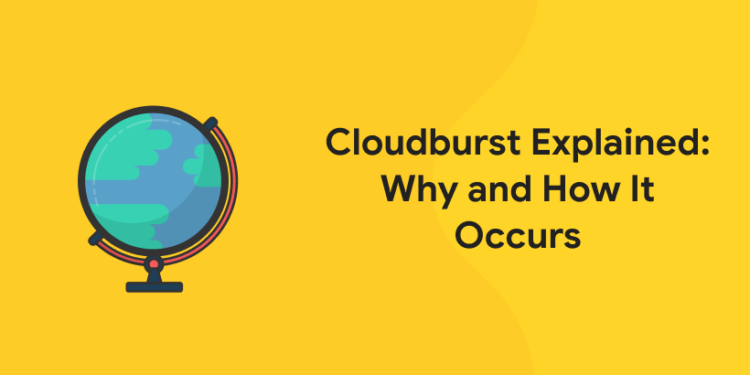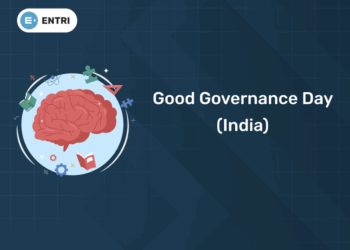Will the clouds blast? Well, the answer is yes. The Clouds will also burst. How does it happen? Here we precisely describe what is a cloudburst exactly? How it forms, and its causes and effects.
What is cloudburst?
Cloudbursts are sudden, heavy rainfall over a small area, approximately 20-30 square km in a short period. It is a weather phenomenon that occurs in connection with thunderstorms and hail, with unexpected precipitation exceeding 100 mm/h, which may cause flood conditions.
Attempt GK and Current affairs Mock Test! Download Entri App now!
The word cloudburst
Cloudbursts are especially common in desert and mountain areas. The term “cloudburst” originated from the idea that clouds were like water balloons and could burst, resulting in rapid precipitation. Though the theory has since been disproven, the phrase stays in use.
How does Cloudburst happen- The process
Various studies imply that they are small-scale manifestations of intense vortices that generate strong convection currents that lift moisture-laden air quickly enough to form cumulonimbus clouds that shed water load with high pressure and ferocity.
Cloudbursts occur when warm air current from the ground or below the clouds surges up, carrying the precipitation with it. The rain failed to fall in a steady shower, which causes excessive condensation in the clouds as fresh drops form and old ones are driven back into it by the updraft.
How is cloudburst different from rainfall?
Rain is condensed water falling from a cloud, while cloudburst is a sudden, heavy rainstorm that falls over a small area in a short duration.
The only difference between raindrops and cloudbursts, according to the Down to Earth report, is the volume of rainfall reported. Rainfall over 100mm per hour is considered a cloudburst.
Consequences of Cloudburst
Does cloudburst have consequences? Unexpected cloudbursts with hails and thunderstorms can cause floods and other natural disasters. Hope you heard about the flood that hit several Indian states recently, notably Himachal Pradesh and Uttarakhand.
Cloudbursts have the following effects;
- Flash flood
- Mudflows
- Land caving
- Landslides
Attempt GK and Current affairs Mock Test! Download Entri App now!
Does climate change increase the cause of cloudburst?
The World Meteorological Organization estimated in May 2021 that there is a 40% possibility that the annual average global temperature will rise by 1.5°C above pre-industrial levels in at least one of the next five years. It also stated that there is a 90% chance that at least one year between 2021 and 2025 will be the warmest on record, displacing 2016 from the top spot. As the temperature rises, the atmosphere can hold more moisture, which falls in a brief burst of heavy rain lasting only a half-hour or an hour, generating flash floods in mountainous areas and urban floods in cities. As a result, scientists predict that with a rising temperature or climate change, we will have more of these cloudburst events in the future.
Can we predict cloudburst?
According to the Indian Methodological Department, It is hard to predict cloudbursts due to their small scale span and time. To deal with cloudburst magnitude, we either need a dense radar network in places prone to cloudbursts or very high-resolution weather forecasting models to resolve, they stated.
Cloudburst in India
- September 14, 2012; there was a cloudburst in Ukhimath, Rudraprayag district, Uttarakhand, which caused 39 deaths.
- August 1, 2013; On the first night of August, heavy rainfall and cloudbursts caused landslides and flash floods in Kargil village. Suru River water began to overflow and spill into the territory. It also washed away a portion of the Srinagar-Leh National Highway.
- July 30, 2014; A landslide occurred in Malin village in Pune, killing around 20 people.
- September 6, 2014; There was a cloudburst in the Kashmir valley, killing more than 200 people. The Center for Science and Environment (CSE) mentioned heavy and unregulated development aggravated the development in the region.
- December 2, 2015; Chennai city recorded 494 rain, resulting in south India floods 2015. The floods saw 400+ casualties.
- July 5, 2017; Haridwar had 102 mm of rain in an hour, causing a massive cloudburst.
- August 2019; 48 people died after a portion of a hill came down in Kavalappara near Nilambur, Malappuram district, Kerala.
- August 2020; A landslide took out a colony of tea plantation workers in Pettimudi, Idukki district, killing 74 people.
- August 2020; A section of a hill crumpled in Kavalappara in Nilambur, Malappuram district, Kerala, killing 48 persons.
Though Cloudbursts are hard to predict in advance, our current technologies and satellite systems can foresee their possibility and risk within a few hours of their occurrence. In the altered climate, we should be ready to expect the unexpected anytime. Cloudburst is normal as anything. What is required is not dread but rather awareness to face it.
Attempt GK and Current affairs Mock Test! Download Entri App now!













